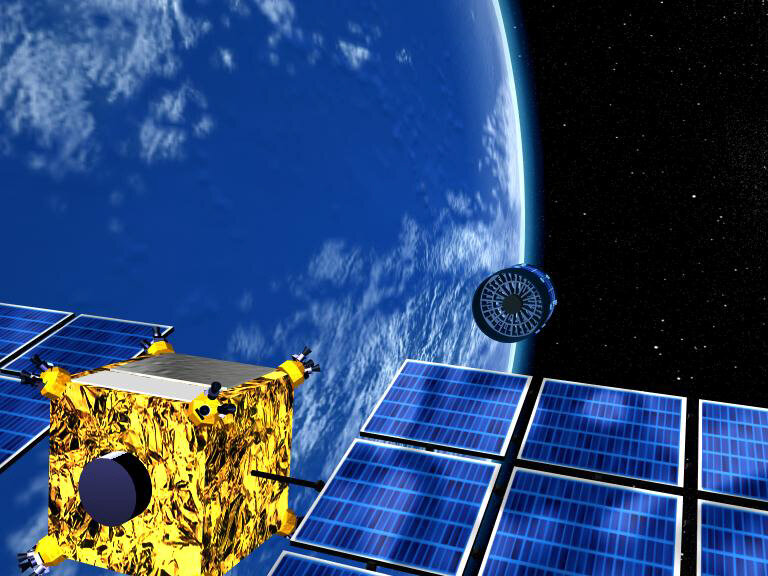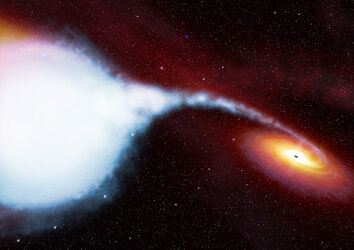XEUS overview
Objective
XEUS will be a permanent space-borne X-ray observatory, 200 times more sensitive than XMM-Newton, studying black holes, galaxy groups, clusters and the interstellar medium.

For more in-depth scientific and technical details of our Space Science Programme and missions, follow this link.
Mission

The X-ray Evolving Universe Spectroscopy (XEUS) mission is the potential follow-on to ESA’s highly successful XMM-Newton mission.
XEUS will be an enormous free-flying X-ray observatory, consisting of two spacecraft (one carrying the mirror, the other carrying the detectors) in formation, flying 50 metres apart. It is designed to search for the first giant black holes that formed in the Universe, over 10 000 million years ago.
What's special?
The main target for XEUS is a background glow of X-rays that seems to fill the entire sky. Spectroscopy is at the heart of XEUS and a key capability is to be able to distinguish in this glow the different spectral components from distant active galaxies.
Beyond our own Galaxy, the millions upon millions of stars that we call the Milky Way, astronomers see a wide Universe lit by millions of such galaxies. As telescopes peer deeper into space they look farther back in time. Light from the most distant galaxies takes about 10 000 million years to reach us, and we see them in their infancy. Look beyond them and you return to a 'Dark Age' without stars, when the young Universe was about to form stars and galaxies. Many of the background X-rays may come from that period, so XEUS will contribute big discoveries about the very hot, young Universe.
Visible starlight is very cool by comparison with the millions of degrees needed to generate X-rays. Microwave and infrared rays, studied by other space telescopes, come from even cooler sources. Yet most of the observable matter in the Universe today is in a hot state, radiating short-wavelength ultraviolet rays and X-rays. Massive clouds of gas at a very high temperature fill the spaces between clustered galaxies.
How did the Universe get so hot? The only adequate source of energy is gravity, dragging material together in against the general expansion of the Universe. Whenever a new star is created in our Milky Way, a collapsing cloud of gas achieves core temperatures sufficient to ignite the nuclear reactions that power the star. The real problem is to stop the collapsing gas from becoming so hot that it blows itself apart before it can make a star. Nature overcomes this snag by radiating energy from molecules and dust in the gas cloud.
Conditions in the primeval Universe were quite different from those in the Milky Way today. With only a few molecules and no dust available for cooling, so the theory goes, only the most massive clouds could collapse. They would in turn make massive stars which would live only short lives before exploding, leaving behind black holes with the mass of a few suns. These black holes would devour nearby material and grow, becoming million solar mass giants. X-rays produced in the vicinity of many such giant black holes could explain the cosmic X-ray background.
Due to XEUS’s large telescope area, and high-efficiency cryogenic instruments with wide energy ranges, XEUS will have a much improved capability over the Reflection Grating Spectrometer on XMM for spectroscopic studies. If lines can be resolved in spectra from compact objects like neutron stars, then both the mass and radius of these objects can be determined. This would provide a powerful tool for the study of matter under some of the most extreme conditions imaginable.
Spacecraft
In order to study these distant black holes, XEUS needs to be much more sensitive than XMM-Newton. In fact, XEUS requires a breakthrough in X-ray optics technology, even compared to the world-beating mirror technology used by ESA’s XMM-Newton.
Here, X-rays are focused by glancing them off the inside faces of bucket-shaped mirrors through which they pass. But these are no ordinary buckets.
Each of XMM-Newton's three telescopes has many mirrors accurately nested inside one another. Every mirror is carefully shaped to give it the correct mathematical form, part parabolic and part hyperbolic. Polished gold of extraordinary smoothness coats the reflecting surfaces.
Fortunately, for the astronomers who want to use XEUS, it appears that the breakthrough required has happened! It is called ‘high-precision micro-pore optics’, and instead of the nickel buckets used by XMM-Newton, it uses much finer silicon tubes to focus the X-rays. These allow much lighter and stronger optics which at the same time give sharper vision, down to about one-thousandth of a degree, to avoid confusion between distant objects lying close together in the sky.
As well as the telescopes, the detectors used to capture the X-rays are very important. The proposed XEUS sensor configuration has an Advanced Pixel Sensor at the centre of a larger, more conventional, Charge Coupled Device (CCD) array with a hard X-ray detector mounted beneath the CCDs. Additionally, four more detectors (called high-count rate Silicon drift diodes) would be positioned around the outer edge of the conventional CCDs. All these instruments could be operated in parallel.
Alternatively, one of two small field-of-view cryogenic detectors could be placed in the focal plane for high spectral resolution studies. This combination of new-generation detectors will perfectly complement the capabilities of the breakthrough optics!
Together with an effective mirror area of 10 m2 these will allow fundamental predictions of General Relativity to be tested – such as the existence of black hole event horizons. The XEUS capabilities in the classical X-ray energy range (0.1-10 keV) will also be extended to higher energies (up to 80 keV) by using graded multi-layer coatings on the XEUS optics. This technology, together with the long focal length and the latest generation of hard X-ray detectors, offers outstanding high-energy spatial resolution and sensitivity.
The predicted final sensitivity is approximately 1000 times better than currently achieved below 80 keV by the instruments on ESA’s Integral gamma-ray observatory. Of course, at higher energies, Integral still provides an unsurpassed capability (up to 10 MeV).
With initially 200 times better sensitivity than XMM-Newton and its vastly improved spectroscopic and timing capabilities, XEUS will be the next logical step in studies of the evolving Universe.
Journey
XEUS will be placed into orbit at the second Earth-Sun Langrangian point L2.
History
XEUS came into being after a meeting held by eminent X-Ray astronomers in Leicester, United Kingdom, in 1996, which produced a report called 'Next Generation of X-Ray Observatories'. The meeting was called to provide ideas for future X-ray missions after the year 2010 and to develop them into a mission, expanding on the goals of the successful XMM-Newton mission.
Originally, the XEUS concept was going to use obtain a mirror area of 30 m2 sufficient to sensitively probe the environment of the massive black holes. Such a large mirror area would need a long focal length of around 50 metres, which makes a single spacecraft impractical. Thus, XEUS would consist of separate mirror and detector spacecraft flying in formation and separated by the focal length.
If the conventional technology of nickel X-ray optics were to be used, as in XMM-Newton, such a large mirror area could best be achieved by rendezvous and docking of the mirror spacecraft to the International Space Station (ISS), where the massive mirror segments would be added by the robotic assembly arm after being delivered to the ISS by the Space Shuttle.
Significant work was carried out in industry to confirm the feasibility of this concept. There were disadvantages of this approach, such as the complexity and cost of multiple launches and the qualification of the mirror spacecraft to visit the ISS. However, following the Columbia tragedy, it became clear that the number of further Space Shuttle flights to the ISS were limited, and unlikely to be able to transport the mirror extension.
The XEUS Science Advisory Group then approved a revised mission concept which asked for the maximum effective telescope area achievable without visiting the ISS. The greatest challenge to such a concept was the development of lightweight optics to provide a mirror area of 10 m2 that with a single launch can be sent, together with the detector spacecraft, to the second Earth-Sun Lagrangian point (L2).
Also in the original concept, the lifetime of the detector spacecraft was limited by fuel usage since it had to track the mirror spacecraft at 50 metres away, and so was always in a non-Keplerian orbit. At L2, this is no longer a major issue, resulting in the possibility of a much longer lifetime, as well as higher operational efficiency.
Partnerships
The many new and challenging technologies that are needed for XEUS are being jointly studied by ESA and the Institute of Space and Astronautical Science (ISAS, now part of the Japan Aerospace Exploration Agency, JAXA). It is hoped that other partners may join the partnership building the first truly global X-ray observatory.




